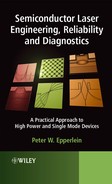Book Description
This reference book provides a fully integrated novel approach to the development of high-power, single-transverse mode, edge-emitting diode lasers by addressing the complementary topics of device engineering, reliability engineering and device diagnostics in the same book, and thus closes the gap in the current book literature.
Diode laser fundamentals are discussed, followed by an elaborate discussion of problem-oriented design guidelines and techniques, and by a systematic treatment of the origins of laser degradation and a thorough exploration of the engineering means to enhance the optical strength of the laser. Stability criteria of critical laser characteristics and key laser robustness factors are discussed along with clear design considerations in the context of reliability engineering approaches and models, and typical programs for reliability tests and laser product qualifications. Novel, advanced diagnostic methods are reviewed to discuss, for the first time in detail in book literature, performance- and reliability-impacting factors such as temperature, stress and material instabilities.
Further key features include:
practical design guidelines that consider also reliability related effects, key laser robustness factors, basic laser fabrication and packaging issues;
detailed discussion of diagnostic investigations of diode lasers, the fundamentals of the applied approaches and techniques, many of them pioneered by the author to be fit-for-purpose and novel in the application;
systematic insight into laser degradation modes such as catastrophic optical damage, and a wide range of technologies to increase the optical strength of diode lasers;
coverage of basic concepts and techniques of laser reliability engineering with details on a standard commercial high power laser reliability test program.
Semiconductor Laser Engineering, Reliability and Diagnostics reflects the extensive expertise of the author in the diode laser field both as a top scientific researcher as well as a key developer of high-power highly reliable devices. With invaluable practical advice, this new reference book is suited to practising researchers in diode laser technologies, and to postgraduate engineering students.
Table of Contents
- Cover
- Title Page
- Copyright
- Dedication
- Preface
- About the author
- Part I: Diode Laser Engineering
- Part II: Diode Laser Reliability
- Overview
- Chapter 3: Basic diode laser degradation modes
- Chapter 4: Optical strength engineering
- Chapter 5: Basic reliability engineering concepts
- Introduction
- 5.1 Descriptive reliability statistics
- 5.2 Failure distribution functions – statistical models for nonrepairable populations
- 5.3 Reliability data plotting
- 5.4 Further reliability concepts
- 5.5 Accelerated reliability testing – physics–statistics models
- 5.6 System reliability calculations
- References
- Chapter 6: Diode laser reliability engineering program
- Part III: Diode Laser Diagnostics
- Overview
- Chapter 7: Novel diagnostic laser data for active layer material integrity; impurity trapping effects; and mirror temperatures
- Chapter 8: Novel diagnostic laser data for mirror facet disorder effects; mechanical stress effects; and facet coating instability
- Chapter 9: Novel diagnostic data for diverse laser temperature effects; dynamic laser degradation effects; and mirror temperature maps
- Introduction
- 9.1 Thermoreflectance microscopy for diode laser diagnostics
- 9.2 Thermoreflectance versus optical spectroscopies
- 9.3 Lowest detectable temperature rise
- 9.4 Diode laser mirror temperatures by micro-thermoreflectance
- 9.5 Diode laser mirror studies by micro-thermoreflectance
- 9.6 Diode laser cavity temperatures by micro-electroluminescence
- 9.7 Diode laser facet temperature – two-dimensional mapping
- References
- Index
